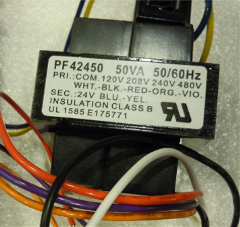
While our customers are wholesalers, Packard knows that you, the contractor, have a choice. You are often presented with many buying options, and being well-informed about your purchase can help make your job easier and more successful. Our Tech Tips are also very helpful for our wholesalers as we present product information that can help as contractors have questions.
This is why we have dedicated a section of our site for contractors and wholesalers. In this section, you will find helpful product tips, tools and some clips from our training classes. We’ve also provided a distributor locator so you can find the nearest wholesaler who can give you access to Packard products.
Transformers: Primary and Secondary Voltage
Transformers & Voltage Easily Explained
Transformers operate on the principal of induction. Two coils, a primary and a secondary, are independently wound around a lamination stack. There is no electrical connection between the two coils. When power is applied to the primary coil an electromagnetic field is developed. This induces voltage into the secondary coil. The amount of voltage produced in the secondary coil is determined by the voltage applied to the primary coil and the resistance in the primary and secondary coils. The resistance in the coils is determined by the wire size and the number of turns in each coil.
Can You Use A 240 Volt Transformer For 208 Volts?
By applying a voltage different than its rating to a primary coil connection of a transformer, the resultant secondary voltage will not be at its rating. This could create excessive heat in the coil of the device being operated, such as a contactor, relay, or other control. This could result in premature failure of the device. It could also lead to poor connections of the contacts within the devices, leading to pitted, and even welded, contacts, again leading to premature failure. So, to answer the question, no you cannot use a 240 volt transformer for 208 volts.

Fig.1
Example From Fig. 1
The transformer shown in Fig. 1 has multiple options for primary voltages. When connected properly, 120 Volts, 208 Volts, 240 Volts, or 480 Volts can be applied. The resultant voltage will be 24 Volts. If connecting a source voltage of 208, for example, one leg of power would be applied to the WHITE primary lead and the second leg of power would be applied to the RED primary lead. The resultant two legs of 24 Volts in the secondary would be through the BLUE and YELLOW secondary leads.
Secondary Voltage & Load Support
Another consideration with transformers is the amount of load that the secondary voltage can support. Fig. 1 shows that this transformer is rated 50 VA, that is 50 Volt Amps. If you divide 50 by the secondary voltage of 24 Volts you can determine that the total Amps this secondary voltage will support is 2.08 Amps. You can connect multiple devices to the secondary as long as they are all rated 24 Volts and the total Amp load does not exceed 2.08 Amps.
Key Takeaways
Being aware of these characteristics will not only allow you to more confidently select the correct transformer, but may also result in maximizing the life of the devices that are being operated by it. If you're looking to learn more about transformers and answers to other HVAC questions check out our YouTube channel, Packard Academy.



Leave a comment